Description
Warning
* Cardiovascular Risk
The use of NSAIDs particularly at high doses and in long term treatment may be associated with a small increased risk of arterial thrombotic events (for example myocardial infarction or stroke.).
Appropriate monitoring and advice are required for patients with a history of hypertension and/or mild to moderate congestive heart failure as fluid retention and oedema have been reported in association with NSAID therapy.
* Gastrointestinal Risk
NSAIDs cause an increased risk of serious gastrointestinal adverse events including inflammation, bleeding, ulceration, and perforation of the stomach or intestines, which can be fatal. These events can occur at any time during use and without warning symptoms.
Pharmaceutical form
Suppositories
Clinical particulars
Therapeutic indications
Treatment of:
– Inflammatory and degenerative forms of rheumatism: rheumatoid arthritis, juvenile rheumatoid arthritis, ankylosing spondylitis, osteoarthritis and spondylarthritis, painful syndromes of the vertebral column, non-articular rheumatism.
– Post-traumatic and post-operative pain, inflammation, and swelling, e.g. following dental or orthopaedic surgery.
– As an adjuvant in severe painful inflammatory infections of the ear, nose, or throat, e.g. pharyngotonsillitis, otitis. In keeping with general therapeutic principles, the underlying disease should be treated with basic therapy, as appropriate. Fever alone is not an indication.
Posology and method of administration:
Children aged 6 years or over should be given 0.5-1 mg/kg body weight daily, in 2-3 divided doses, depending on the severity of the disorder.
Contraindications:
Gastric or intestinal ulcer. Known hypersensitivity to the active substance. Like other non-steroidal anti-inflammatory drugs (NSAIDs), Baby relief 12.5 is also contraindicated in patients in whom attacks of asthma, urticaria, or acute rhinitis are precipitated by acetylsalicylic acid or other drugs with prostaglandin-synthetase inhibiting activity. Proctitis.
Special warnings and special precautions for use
Warnings
In the rare cases where gastrointestinal bleeding or ulceration occurs in patients receiving Baby relief 12.5, the drug should be withdrawn. As with other NSAIDs, allergic reactions, including anaphylactic/anaphylactoid reactions, can also occur in rare cases without earlier exposure to the drug. Like other NSAIDs, Baby relief 12.5 may mask the signs and symptoms of infections due to its phamacodynamic properties.
Baby relief 12.5 is not to be used for children less than 6 years.
Precautions
Close medical surveillance is imperative in patients with symptoms indicative of gastrointestinal disorders or a history suggestive of gastric or intestinal ulceration, in patients with ulcerative colitis or Crohn’s disease, and in patients suffering from impaired hepatic function. As with other NSAIDs, values of one or more liver enzymes may increase. During prolonged treatment with Baby relief 12.5, monitoring of hepatic function is indicated as a precautionary measure. If abnormal liver function tests persist or worsen, if clinical signs or symptoms consistent with liver disease develop, or if other manifestations occur (e.g. eosinophilia, rash, etc.) Baby relief 12.5 should be discontinued. Hepatitis may occur without prodromal symptoms. Caution is called for when using Baby relief 12.5 in patients with hepatic prophyria, since it may trigger an attack. Owing to the importance of prostaglandins in maintaining renal blood flow, particular caution is called for in patients with impaired cardiac or renal function. Monitoring of renal function is recommended as a precautionary measure when using Baby relief 12.5 in such cases. Discontinuation of therapy is usually followed by recovery to the pretreatment state. During prolonged treatment with Baby relief 12.5, as with other NSAIDs, monitoring of blood count is recommended. Like other NSAIDs, Baby relief 12.5 may temporarily inhibit platelet aggregation. Patients with defects with haemostasis should be carefully monitored.
Interactions with other medicaments and other forms of interactions
(Including interactions observed with other pharmaceutical forms of diclofenac sodium).
Lithium, digoxin: diclofenac sodium may raise plasma concentrations of lithium and digoxin.
Diuretics: like other NSAIDs, diclofenac sodium may inhibit the activity of diuretics.
Concomitant treatment with potassium-sparing diuretics may be associated with increased serum potassium levels, which should therefore be monitored frequently.
NSAIDs: concomitant administration of systemic NSAIDs may increase the frequency of undesirable effects.
Anticoagulants: although clinical investigations do not appear to indicate that diclofenac sodium affects the action of anticoagulants, there are isolated reports of an increased risk of haemorrhage in patients receiving BABY RELIEF 12.5 and anti-coagulants concomitantly. Close monitoring of such patients is therefore recommended.
Antidiabetics: diclofenac sodium can be given together with oral antidiabetic agents without influencing their clinical effect. However, isolated cases have been reported of both hypoglycaemic and hyperglycaemic effects necessitating changes in the dosage of hypoglycaemic agents during treatment with Baby relief 12.5.
Methotrexate: caution is called for when NSAIDs are administered less than 24 hours before or after treatment with methotrexate, since blood concentrations of methotrexate may rise and the toxicity of this substance be increased.
Cyclosporin: the effects of NSAIDs on renal prostaglandins may increase the nephrotoxicity of cyclosporin.
Quinolone antibacterials: there have been isolated reports of convulsions which may have been due to concomitant use of quinolones and NSAIDs.
Undesirable effects
Frequency estimate: frequency more than 10%, occasional more than 1%-10%, rare more than 0.001%-1%, isolated cases less than 0.001%.
Gastrointestinal tract
Occasional: epigastric pain, nausea, vomiting, diarrhea, abdominal cramps, dyspepsia, flatulence, anorexia, local irritation.
Rare: gastrointestinal bleeding (haematemesis, melaena, bloody diarrhoea), gastric or intestinal ulcer with or without bleeding or perforation.
Isolated cases: aphthous stomatitis, glossitis, oesophageal lesions, diaphragm-like intestinal strictures, lower gut disorders such as non-specific haemorhhagic colitis and exacerbation of ulcerative colitis or Crohn’s disease; constipation, pancreatitis, exacerbation of haemorrhoids.
Central nervous system
Occasional: headache, dizziness, vertigo.
Rare: drowsiness.
Isolated cases: sensory disturbances, including paraesthesias, memory disturbances, disorientation, insomnia, irritability, convulsions, depression, anxiety, nightmares, tremor, psychotic reactions, aseptic meningitis.
Special senses
Isolated cases: disturbances of vision (blurred vision, diplopia), impaired hearing, tinnitus, taste disturbances disorders.
Skin
Occasional: rashes.
Rare: urticaria.
Isolated cases: bullos eruptions, eczema, erythema multiform, Stevens-Johnson syndrome, Leyll’s syndrome (acute toxic epidermolysis), erythroderma, (exfoliative dermatitis), loss of hair, photosensitivity reaction, purpura, including allergic purpura.
Kidney
Rare: oedema.
Isolated cases: acute renal failure, urinary abnormalities such as haematuria and proteinuria, interstitial nephritis, nephrotic syndrome, papillary necrosis.
Liver
Occasional: elevation of serum aminotransferase enzymes.
Rare: hepatitis with or without jaundice.
Isolated cases: fulminant hepatitis.
Blood
Isolated cases: thrombocytopenia, leucopenia, haemolytic anaemia, aplastic anaemia, agranulocytosis.
Hypersensitivity
Rare: hypersensitivity reactions such as asthma, systemic anaphylactic/anaphylactoid reactions including hypotension.
Isolated cases: vasculitis, pneumonitis.
Cardiovascular system
Isolated cases: palpitation, chest pain, hypertension, congestive heart failure.
Overdose
Management of acute poisoning with NSAIDs consists essentially of supportive and symptomatic measures. There is no typical clinical picture associated with overdosage of diclofenac sodium. Supportive and symptomatic treatment should be given for complications such as hypotension, renal failure, convulsions, gastrointestinal irritation, and respiratory depression. Forced diuresis, dialysis, or haemoperfusion are unlikely to be helpful in accelerating the elimination of NSAIDs because of their high protein-binding rate and extensive metabolism.
Pharmacological properties
Pharmacodynamic properties
Phamacotherpeutic group
Non-steroidal anti-inflammatory drug (NSAID).
Mechanism of action
Baby relief 12.5 contains diclofenac sodium, a non-steroidal anti-inflammatory compound with pronounced antirheumatic, anti-inflammatory, analgesic, and antipyretic properties. Inhibition of prostaglandin biosynthesis, which has been demonstrated in experiments, is considered fundamental to its mechanism of action. Prostaglandins play a major role in causing inflammation, pain, and fever. Diclofenac sodium in vitro does not suppress proteoglycan biosynthesis in cartilage at concentrations equivalent to those reached in humans.
Pharmacodynamic effects
In rheumatic diseases, the anti-inflammatory and analgesic properties of diclofenac sodium elicit a clinical response characterized by marked relief from signs and symptoms such as pain at rest, pain on movement, morning stiffness, and swelling of the joints, as well as by an improvement in function.
In post-traumatic and postoperative inflammatory conditions, diclofenac sodium rapidly relieves both spontaneous pain and pain on movement and reduces inflammatory swelling and wound oedema. Diclofenac sodium also exert a pronounced analgesic effect in moderate and severe pain of non-rheumatic origin.
Pharmacokinetic properties
Absorption
Diclofenac shows a rapid onset of absorption from suppositories, although the rate of absorption is slower than from gastro-resistant tablets administered orally. After the administration of suppositories, peak plasma concentrations are attained on average within 1 hour, but maximum concentrations per dose unit are about two thirds of those reached after administration of gastrointestinal tablets. The amount absorbed is linearly related to the size of the dose. Since about half of diclofenac is metabolized during the first passage through the liver (“first pass” effect), the area under the concentration curve (AUC) following rectal administration is about half that following an equivalent parenteral dose. Pharmacokinetic behavior does not change after repeated administration. No accumulation occurs provided the recommended dosage intervals are observed. The plasma concentrations attained in children given equivalent doses (mg/kg body weight) are similar to those obtained in adults.
Distribution
99.7% of diclofenac is bound to serum proteins, mainly to albumin 99.4%. The apparent volume of distribution calculated is 0.12-0.17 L/kg. Diclofenac enters the synovial fluid, where maximum concentrations are measured 2-4 hours after peak plasma values have been attained. The apparent half-life for elimination from the synovial fluid is 3-6 hours. Two hours after reaching peak plasma values, concentrations of the active substance are already higher in the synovial fluid than in the plasma, and they remain higher for up to 12 hours.
Biotransformation
Biotransformation of diclofenac takes place partly by glucuronidation of the intact molecule, but mainly by single and multiple hydroxylation and methoxylation, resulting in several phenolic metabolites (3′-hydroxy-4′-hydroxy-,5-hydroxy-,4′,5-dihydroxy- and 3′-hydroxy-4′-methoxy-diclofenac), most of which are converted to glucuronide conjugates. Two of these phenolic metabolites are biologically active, but to a much smaller extent than diclofenac.
Elimination
Total systemic clearance of diclofenac from plasma is 26356 ml/min (mean value SD). The terminal half-life in plasma is 1-2 hours. Four of the metabolites, including the two active ones, also have short plasma half-lives of 1-3 hours. One metabolite, 3′-hydroxy-4′-methoxy-diclofenac has a much longer plasma half-life. However, this metabolite is virtually inactive. About 60% of the administered dose is excreted in the urine as the glucuronide conjugate of the intact molecule and as metabolites, most of which are also converted to glucuronide conjugates. Less than 1% is excreted as unchanged substance. The rest of the dose is eliminated as metabolites through the bile in the faeces.
Characteristics in patients
No relevant age-dependent differences in the drug’s absorption, metabolism, or excretion have been observed. In patients suffering from renal impairment, no accumulation of the unchanged active substance can be inferred from the single-dose kinetics when applying the usual dosage schedule. At a creatinine clearance of less than 10 ml/min, the calculated steady-state plasma levels of the hydroxy metabolites are about 4 times higher than in normal subjects. However, the metabolites are ultimately cleared through the bile. In patients with chronic hepatitis or non-decompensated cirrhosis, the kinetics and metabolism of diclofenac are the same as in patients without liver disease.
Incompatibilities
None known.
Special precautions for storage
Protect from heat store at a temperature not exceeding 30oC.
Medicines should be kept the out of reach of children.
Instructions for use/handling
Not to be taken by mouth. The suppositories should not be cut apart, as incorrect storage conditions may lead to uneven distribution of the active substance.
Packs
A carton box containing 5 suppositories in a PVC-PE strip and a pamphlet.
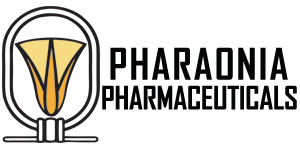

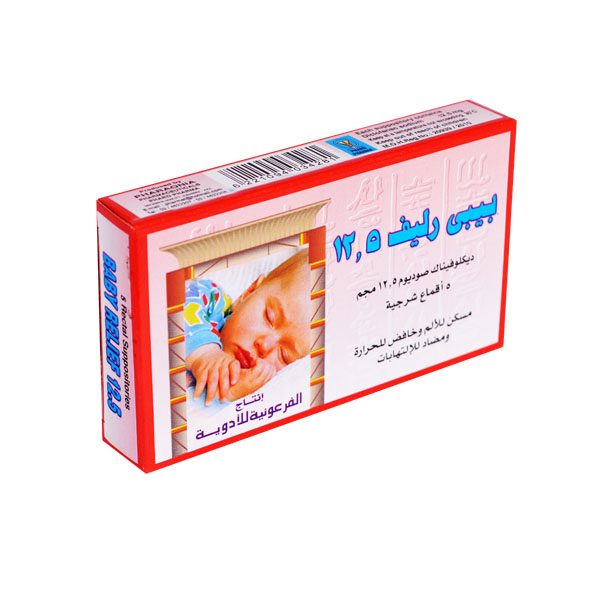
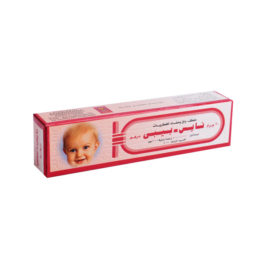
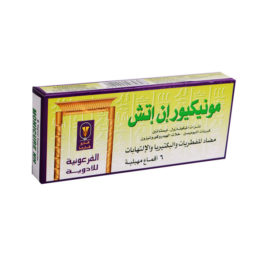
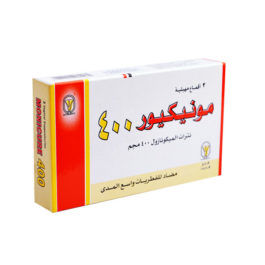
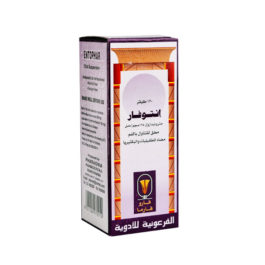
Reviews
There are no reviews yet.